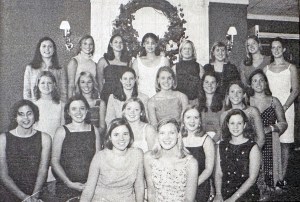The Town Crier: City limit limits (part 3)
Published 11:00 am Sunday, August 13, 2023

- The Town Crier
When Varnell, Dalton and Whitfield County decided to standardize their zoning ordinance, the goal was to make it easier, safer, and to have combined codes to assist developers, business folks and homeowners in knowing what they needed to know.
At the start of the document, called the Unified Zoning Ordinance, there is a list of words and terms that are defined as to what is specifically being talked about later in the document. For example, when reading about a crosswalk in the document the reader can flip to the front to see specifically what is meant. The definition is for “a right-of-way within a block dedicated to public use, intended primarily for pedestrian use designed to provide access to adjacent roads and lots.” That’s a relief if you’ve got a stable on one side of the road and a pasture on the other, since it says “primarily” for pedestrian use but leaves it open for the occasional need to get a horse from one side of the road to the other. Mr. Ed would be relieved. This also allows our area’s chickens to cross the road in the event of a situation necessitating a joke.
Trending
Which brings up the important definition for a rural area like ours of livestock. That includes “cattle, horses, goats, sheep, swine, poultry, ducks, geese and other fowl; and rabbits, minks, foxes and other fur or hide-bearing animals.”
I don’t see donkeys, burros or mules on there, but surely the ordinance inspector would check the “horse” box on the form for any of them. If we were in Egypt, this list would include camels; if in Thailand, elephants; and if Australia, kangaroos; and of course, if the North Pole, flying reindeer. You would probably need a separate permit for reindeer games, though.
There is also a definition for “small animals … kept for non-commercial purposes,” which is a long way of saying pets. Aren’t you glad you don’t have to say “The kids are so happy, we got three new small animals we’re keeping for non-commercial purposes. We named them Mittens, Callie and Socks.” Actually, the small animals listed here are more like farm animals kept as pets or maybe food, since cats and dogs aren’t listed as examples, but chickens and turkeys are. and also chinchillas. If you have a good recipe for chinchilla casserole I don’t want to know it.
When it comes to the holidays (or a Hallmark holiday special!) there are definitions for “Holiday Tree and Produce Farm” and for a “Temporary Holiday Tree Lot.” The holiday farm is where the Christmas trees, Halloween and Thanksgiving pumpkins and other related fruits are grown. Tours, and things like corn mazes, are allowed to create a true agri-entertainment working farm. If the farmers would push more for Arbor Day gift giving and a Fourth of July Liberty Tree tradition, they could probably have sales year round and not just in the fall and early winter.
Crackers, yes; firecrackers, no
On the other hand, there is a category called “Home Occupation” which sounds like when you get termites if you ask me, but occupation here means business or livelihood. Your garden does not count as a home occupation. Home occupation is a business you run out of your home but the main parts of the restrictions set forth are all about keeping your home looking like a home for the sake and property values of your neighbors.
Trending
If you’ve got a business baking specialty crackers, for example, you can’t have workers hired that don’t live in the home, you can’t have a separate entrance just for the business and you can’t have a giant semi-truck for your company idling in the driveway all night. I had an idea for a home occupation of my own, but turns out no dangerous or hazardous materials are allowed in a home occupation, so there goes my dreams of a one-man, hand-made custom fireworks factory going in the basement. Crackers, yes; firecrackers, no.
If you read the Town Crier a few weeks ago dealing with “rust gardens” and the tradition, shall we say, of old cars sitting around the yard, the Unified Zoning Ordinance has a definition of “Junk Vehicles.” This includes “automobiles, vehicles or parts thereof which is in an inoperative condition.” So apart from a junk car in your yard, you could also have a junk bulldozer, a junk airplane or a junk boat sitting around, or parts of them.
If they worked, they’re not junk, although how a “parts thereof” of a car could be operable is beyond me. If they are inoperable because the vehicle is out of gas, that doesn’t count as “junk.” If they are inoperable because of “having been wrecked, dismantled, partially dismantled, abandoned or discarded,” they are. But don’t worry, shade-tree mechanics working on that classic rebuild of your ’57 Chevy dream car, it’s not junk if it’s in the garage, carport or in a shed.
Putting the O in Oktoberfest
Dalton now has need of a definition for micro-brewery and micro-distillery. How micro? Not as micro as you might think. A micro-brewery serving up beer can make up to 10,000 gallons of brewskis. There are 16 pitchers of beer to a gallon so that comes out to 160,000 pitchers of beer on the wall. That puts the capital “O” in Oktoberfest if you ask me.
And for a micro-distillery, where we used to be a dry county, now a single distillery (or winery) can make up to 60,000 gallons a year. That’s more than enough to make Otis from “The Andy Griffith Show” lick his lips. I personally don’t drink, so that leaves more for others of you who do. But I am happy I don’t see anything in the ordinances about micro-ice creameries or micro-doughnut shops limiting their output in any way.
For anyone coming to our area for a vacation, or just stopping overnight on the way to here or there, please note there is a difference between a hotel, convention hotel, boutique hotel and a motel. But there is no difference between a motel and a motor court.
One of the odd things I noticed in the ordinance is in the chart for number of required parking spaces for hotels. Did you know that for a non-convention hotel or motel it is required that one parking space per room is provided but that for a convention hotel or motel or with a restaurant or lounge, one and a half parking spaces are required. If you see someone with out of state plates driving half a car, make sure they know about this, OK? We don’t want to lose business because of a lack of parking. and if they have 2.3 children, give me a call, I want to see that.
Non-conforming
With the purpose of this ordinance being standardization for most of our area, there are what are called “non-conforming” definitions. This has nothing to do with your teenagers getting tattoos and dying their hair green (so they conform to look exactly like every other teenager out there), it’s about buildings, lots or uses that were already there when these ordinances were adopted but don’t meet the current requirements.
In popular parlance, these structures or uses are “grandfathered in.” Let’s say you’re known as “Pappy” and you voted for “Ike” and you were raising “show roosters” since before the unified ordinance went in to play, I think you can keep raising them even though they crow loud enough for the neighbors to hear, which is against the rules now.
Now, what happens when your prize-winning Sicilian buttercup “Old Pete” “cock-a’s” his last “doodle-doo,” I don’t know if you get to bring in a new rooster or now that you’ve posthumously met the new requirements have to continue to do so. That’s a question for chicken inspector 23. I would point out that the definition for “nuisance” comes right after these “non-conforming” items.
When it comes to fun, there are listings for “Indoor” and “Outdoor Recreational Facilities.” Indoor examples provided include video game center, bowling alley or shooting gallery. Outdoor include miniature golf, golf driving range, swimming pool, tennis courts and I couldn’t believe it was in here but was really pleased just in case drive-in movie theaters. Just think, the potential for the return of the All-Night Monster Movie Marathon is already there in the ordinance. Now that’s some forward/backward thinking!
As we get to the end of the alphabetical listing of definitions we come to swimming pool which is “an artificial or semi-artificial receptacle or other container intended for swimming.” I’m not sure what a semi-artificial container is, but for it to count as a swimming pool it has to be 18 inches deep. There’s a whole section on “Yards” including diagrams, but I’ll leave that for you to mow over in your mind.
Now that you know how the words are defined, I leave it up to you, or more likely your real estate agent or contractor, to see how they are used in the actual codes. Meanwhile, I’m going to find a grandfather somewhere and stay with him. I dare ‘em to take away our 80-year-old ungrounded electric plug outlets!





